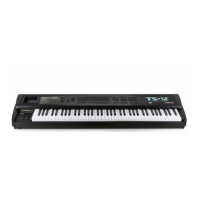Section 7 — Effect Parameters TS-12 Musician’s Manual
34
ROTOR SLOW Range: 00 to 99
Determines the rate of the rotary speaker when in the “Slow” setting. ROTOR SLOW determines
the manual level for the rotary speaker rate when SPEED= SLOW, or when the selected
modulator is at zero output level. Again, the higher the value, the faster the rate.
FAST Range: 00 to 99
Determines the rate of the rotary speaker when in the “Fast” setting. The higher the value, the
faster the rate.
INERTIA Range: 00 to 99
Determines how long it will take for the rotor effect to speed up and slow down after switching
from fast to slow or vice versa. Adjust this parameter to simulate the effect of the rotary speaker
gradually picking up speed.
SPEED Range: SLOW or FAST
Determines how the rotary speaker will switch between slow and fast speeds. The behavior of
the switch accurately reflects an actual rotary speaker, taking time to speed up or slow down,
based on the value of the INERTIA parameter (see previous description). Any effect modulator
can act as the SPEED controller. How the modulators will switch the rotor speed fall into two
categories:
• WHEEL, PBEND, PEDAL, TIMBR, XCTRL, PRESS(ure), KEYBD, and VELOC — These
modulation sources act like a switch to turn on or off the fast rotor speed. To reverse the
polarity of the switch, set ROTOR SLOW faster than ROTOR FAST.
• KEYDN, PATCH, SUSTN, SOSTU, FX-SW — These modulation sources toggle the rotor speed
between slow and fast. Every time the modulation source moves from zero in a positive
direction, the rotating speaker effect changes speeds from slow to fast or fast to slow.
DECAY TIME Range: 0.20 to 100.0
Controls the amount of time it takes for the reverberation to decay to a low level (-60 dB) after the
input signal stops.
HF - DAMPING Range: 00 to 99
Controls the rate of attenuation of high frequencies in the decay of the reverberation. As natural
reverb decays, some high frequencies tend to get absorbed by the environment. Increasing the
value of this parameter will filter out increasing amounts of high-frequency energy.
DIFFUSION Range: 00 to 99
Determines whether the early reflections will appear as a series of discrete echoes (lower values)
or will be more diffused (higher values).
61 SPEAKER CABINET
SPEAKER CABINET simulates the warm sound of an open-back speaker cabinet. SPEAKER
CABINET is fabulous for a guitar, bass or any other stringed instrument sound. This algorithm
contains the resonances and the non linearity of a real musical instrument speaker. The FX-1 and
FX-2 parameters can be routed into the effect with different Dry/Wet mixes. For a brighter
speaker emulation, try using TUNABLE SPEAKER.
OUTPUT GAIN Range: -48 to +24 dB
Since speaker cabinets are “lossy,” output gain is required to compensate losses in perceived
volume. Setting this gain too high will cause clipping of the output signal.

